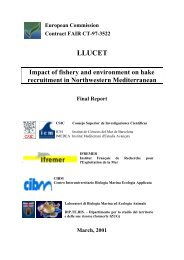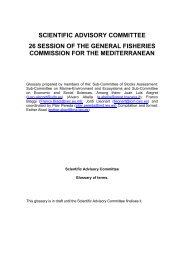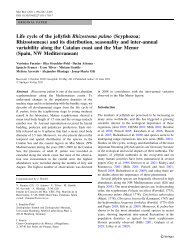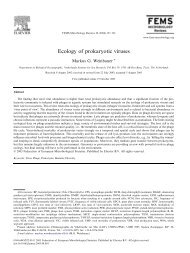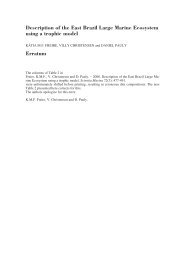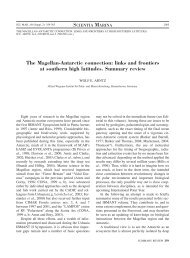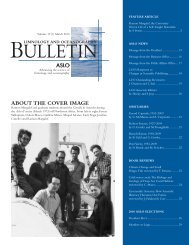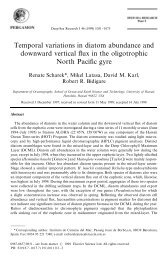REPORT OF THE WORKSHOP ON TRAWL SURVEY ... - FAO.org
REPORT OF THE WORKSHOP ON TRAWL SURVEY ... - FAO.org
REPORT OF THE WORKSHOP ON TRAWL SURVEY ... - FAO.org
You also want an ePaper? Increase the reach of your titles
YUMPU automatically turns print PDFs into web optimized ePapers that Google loves.
may also reflect an effect of changing amounts of unaccounted for removals due to<br />
discarding, misreporting, natural deaths or movements into neighbouring areas. Evidence for<br />
incomplete fishery catch data during periods of TAC reductions lends support to this as an<br />
important factor.<br />
Two procedures have been adopted for cod in the North Sea, Irish Sea and West of Scotland<br />
to deal with the bias. The first involves the use of Time Series Analysis of data for the<br />
Scottish stock, in which survey data are calibrated with fishery catch at age during an earlier<br />
period when catchability was effectively constant, and the model extended into subsequent<br />
years using only the survey data (WGNSDS 2006). A second method (B-Adapt; Darby, 2004)<br />
is a variant of the Adapt model formulation in which all the available fishery data are included<br />
but a bias factor for fishery catches is calculated for a recent period of years. This method is<br />
used for cod in the Irish and North Seas (WGNSDS and WGNSSK 2006). The bias factor is<br />
calculated by adjusting the annual total catch tonnage in the relevant period until the<br />
assumption of constant survey catchability is met as closely as possible.<br />
The B-Adapt model for Irish Sea cod gives total removals figures for 2000 onwards that are<br />
close to independent estimates of total landings based on sampling schemes rather than vessel<br />
logbook data (Fig. 6). The independent estimates were used in the B-Adapt assessment up to<br />
1999, but official data were used for subsequent years due to an absence of independent<br />
estimates for some years. Fig. 6 shows that not accounting for potential biases in catches<br />
since 2000 due to misreporting, causes major retrospective bias in F-estimates. Allowing B-<br />
Adapt to estimate the bias to give constant survey catchability (on average) results in a<br />
removal of the retrospective bias leaving random residuals.<br />
Survey-only assessment methods<br />
Raw survey data<br />
The most parsimonious use of a survey to describe trends in stock biomass and/or year-class<br />
strength is the trend given by the raw data, without any form of smoothing or modelling other<br />
than has been applied to generate the “raw” indices (e.g. through use of geostatistical models,<br />
GLMs or GAMs). Simulation models have shown that design-based estimators such as<br />
stratified means will differ from model-based estimators such as GAMs mainly in the<br />
estimation of error variance, rather than the overall mean. In a time-series context, yeareffects<br />
also occur in trawl survey indices, due to factors such as weather conditions,<br />
unintended changes in gear rigging, or changes in fish behaviour. These act to inflate the<br />
overall variance within a time-series of indices as well as to introduce autocorrelated errors<br />
across age classes. Additional error may be introduced through deficiencies in age-length<br />
keys or errors in ageing.<br />
The great majority of ICES surveys provide age-based data, and the quality of the data can be<br />
quickly screened by examining the internal consistency in tracking year classes over time.<br />
Examples are given later in the section on North Sea haddock.<br />
Survey-only models<br />
Simple catch-curves do not make full use of the information content of the surveys if there are<br />
year or age effects, common to all year classes, that can be estimated through simultaneous<br />
analysis of all the data. Simple catch curves are also not useful for year classes that have only<br />
been surveyed for a few years. If there is temporal stability in the catchability at age for a<br />
stock in a particular survey, this permits the use of a separable model in which “mortality”<br />
52




